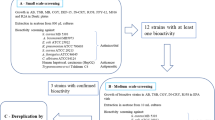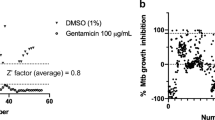Abstract
Three fungal strains, Alternaria alternata, Eurotium chevalieri and Penicillium crustosum were isolated from the normal tissues of the soft coral Litophyton arboreum, collected from the Egyptian Red Sea coast. The ethyl acetate (EtOAc) extracts of their liquid cultures were subjected to primary screening of anticancer and inhibition of hepatitis C virus (HCV) NS3-NS4A protease. As a result, A. alternata showing a high-level inhibition of HCV protease (IC50 14.0 μg/mL) was selected for further investigation on its secondary metabolites. The fungus was identified by its morphology and 18S rDNA. Bioassay-guided fractionation of the EtOAc extract of A. alternata culture broth revealed 5 metabolites: alternariol-9-methyl ether3-O-sulphate, alternariol-9-methyl ether, alternariol, maculosin and maculosin-5. The structures of these metabolites were assigned on the basis of detailed spectroscopic analysis. The biological properties of the isolated compounds were explored for inhibition of HCV NS3-NS4A protease as well as anticancer and antimicrobial activities.
Similar content being viewed by others
References
Strobel, G., Daisy, B., Castillo, U. and Harper, J., J. Nat. Prod., 2004, vol. 67, no. 2, pp. 257–268.
Zhang, H.W., Song, Y.C. and Tan, R.X., Nat. Prod. Rep., 2006, vol. 23, no. 5, pp. 753–771.
Montemurro, N. and Visconti, A., in Alternaria: Biology, Plant Disease and Metabolites, Chelkowski, J. and Visconti, A., Eds., Amsterdam: Elsevier, 1992, p. 449.
Scott, P.M., J. AOAC Int., 2001, vol. 84, no. 6, pp. 1809–1817.
Ackermann, Y., Curtui, V., Dietrich, R., Gross, M., Lativ, H., Märtlbauer, E. and Usleber, E., J. Agric. Food Chem., 2001, vol. 59, no. 2, pp. 6360–6368.
Musetti, R., Polizzotto, R., Vecchione, A., Borselli, S., Zulini, L., D’Ambrosio M., Sanita` di Toppi, L. and Pertot I., Micron, 2007, vol. 38, no. 6, pp. 643–650.
Liebermann, B., Ellinger, R., Günther, W., Ihn, W. and Gallander, H. Phytochemistry, 1997, vol. 46, no. 2, pp. 297–303.
Nussbaum, R–P., Gunther, W., Heinze, S. and Liebermann, B., Phytochemistry, 1999, vol. 52, no. 4, pp. 593–599.
Ma, Y.-T., Qiao, L.-R., Wen-Quan Shi, W-Q., Zhang, A-L., and Gao, J.-M., Chem. Nat. Comp., 2010, vol. 46, no. 3, pp. 504–506.
Stahl, E., Thin-Layer Chromatography: A Laboratory Handbook. 2d ed, Berlin: Springer-Verlag, 1969.
Chomczynski, P., Biotechniques, 1993, vo. 15, no. 3, pp. 532–534.
Hall, T.A., Nucleic Acids Symp. Ser., 1999, vol. 41, no.1, pp. 95–98.
Ragan, M.A., Can. J. Chem., 1978, vol. 56, no. 20, pp. 2681–2685.
Onocha, P.A., Okorie, D.A., Connolly, J.D. and Roycroft, D.S., Phytochemistry, 1995, vol. 40, no. 4, 1183–1189.
Love, R.L., Parge, H.E., Wickersham, J.A., Hoastomsky, Z., Habiuka, N., Moomaw, E.W., Adachi, T. and Hostomska, Z., Cell, 1996, vol. 87, no.2, pp. 331–342.
Wei, Y., Ma, C.M. and Hattori M., Bioorg. Med. Chem., 2009, vol. 17, no. 8, pp. 3003–3010.
Valeriote, F., Grieshaber, C.K., Media, J., Pietra szkiewicz, H., Hoffmann, J., Pan, M. and McLaughlin, S., J. Exp. Ther. Oncol., 2002, vol. 2, no. 4, pp. 228–236.
Cosentino, S., Tuberoso, C.I.G., Pisano, B., Satta, M., Mascia, V., Arzedi, E. and Palmas F., Lett. Appl. Microbiol., 1999, vol. 29, no.2, pp. 130–135.
Author information
Authors and Affiliations
Corresponding author
Additional information
The article is published in the original.
Rights and permissions
About this article
Cite this article
Hawas, U.W., El-Desouky, S., Abou El-Kassem, L. et al. Alternariol derivatives from Alternaria alternata, an endophytic fungus residing in red sea soft coral, inhibit HCV NS3/4A protease. Appl Biochem Microbiol 51, 579–584 (2015). https://doi.org/10.1134/S0003683815050099
Received:
Published:
Issue Date:
DOI: https://doi.org/10.1134/S0003683815050099




